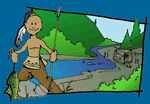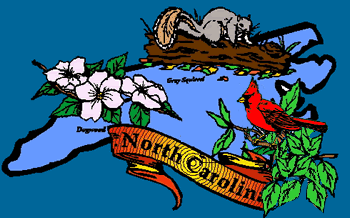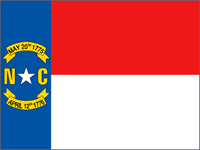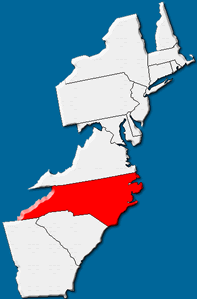


Geography and Landforms:
North Carolina has three distinct topological areas: The Coastal Plain, the Piedmont Plateau and the Blue Ridge/Appalachian Mountains.
|
 History:
The first known exploration of North Carolina by a European came in the summer of 1524 when Giovanni da Verrazano, an Italian explorer serving the country of France, traveled through the coastal area of the state between the Cape Fear River near Wilmington and the area now known as Kitty Hawk. Between 1540 and 1570, several Spanish explorers came north from the Florida Gulf regions and traveled through North Carolina. These explorers did not establish any permanent settlements.
|
 Economy:
North Carolina's economy has grown far more diverse in recent years. The new economic leaders are in the technology and service sectors, which are growing rapidly. However, traditional industries such as agriculture and textile production have helped to make North Carolina the largest agricultural and industrial producer in the Southeastern United States.
|
 First Inhabitants:
When the first Europeans explored North Carolina, the area was home to a large number of native tribes. These tribes fall into three groups based upon their native languages: Iroquois (including the Cherokee, Tuscarora, Meherrin, Coree, and Neuse River tribes), Algonquin (including the Bear River, Chowan, Hatteras, Nachapunga, Moratok, Pamlico, Secotan, and Weapomeoc tribes), and Siouan (including the Cape Fear, Catawba, Cheraw, Eno, Keyauwee, Occaneechi, Saponi, Shakori, Sissipahaw, Sugaree, Tutelo, Waccamaw, Wateree, Waxhaw, and Woccon tribes). The Iroquois tribes inhabited the mountains in the western portion of the state. The Siouan tribes lived in the central piedmont area, and the Algonquin tribes lived in the southern tidewater area.
|
Books Related To North CarolinaBlackbeard's Last Fight - Eric Kimmel Blue - Joyce Moyer Hostetter Dovey Coe - Frances O'Roark Dowell Fallout - Trudy Krisher Freedom on the Menu: The Greensboro Sit-Ins - Carole Boston Weatherford Gentle's Holler - Kerry Madden How to Steal a Dog - Barbara O'Connor Jack Adrift: Fourth Grade without a Clue - Jack Gantos The Legend of Buddy Bush - Shelia Moses Listen! - Stephanie Tolan Rescue on the Outer Banks - Candice Ransom Storm Warriors - Elisa Carbone T is for Tar Heel: A North Carolina Alphabet - Carol Crane |
Famous Citizens:
|
| Capital: | Raleigh |
| Entered Union: | November 21, 1789 |
| Population: | 9,943,964 |
| Area | 53,819 |
| Bird | Cardinal |
| Flower | American Dogwood |
| Nickname: | Old North State |
| Governor | Pat McCrory |
Places to Visit in North Carolina: (Click the links to learn more.)
|



